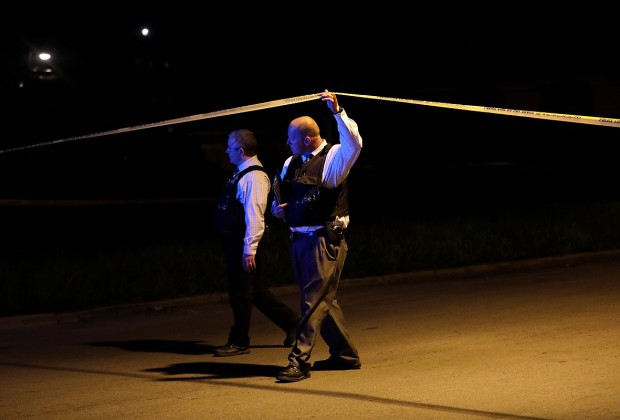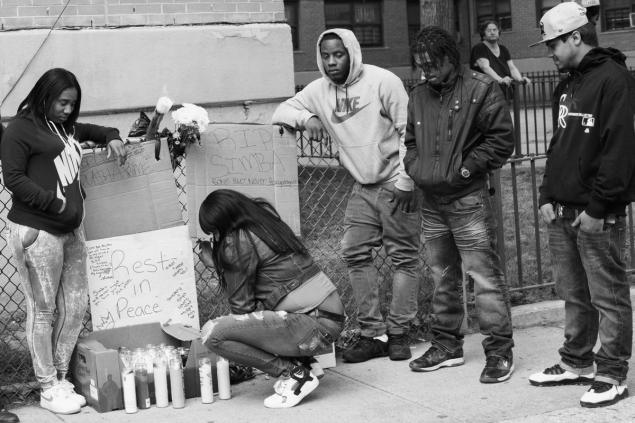One tool researchers have used to identify high-risk group members is social network analysis (SNA). Yale sociologist Andrew Papachristos has developed a mathematical method to identify the structures of street groups using connections contained within police records of arrests, field stops, and similar data. SNA recognizes that the overwhelming majority of suspects and victims in homicides and shootings know one another. In fact, Papachristos has demonstrated that they are often part of a closely linked social network — that is, shooters and victims tend to be closely linked to many other shooters and victims.
Research on these social networks has found that individuals with links to street groups and those closely linked to homicide victims are at elevated risk of becoming shooters or victims themselves. SNA has helped communities identify group members to notify. Using co-arrest and field stop records, SNA can create graphs of connections between street group members. A Group Violence Intervention (GVI) partnership can use these maps to identify “brokers”—people with a profusion of group-related connections—and people closely connected to homicide victims and suspects. These high-risk group members can then be given custom notifications to give the city’s antiviolence message the greatest reach and to disrupt street group networks.
Network Analysis and Visualization for Crime Prevention (NAVCAP) is a software program designed to visualize and conduct basic analyses on networks of groups and individuals who are often involved in gun violence. The software allows users to examine co-arrest (or other event) data in which individuals or groups are linked to each other through "co-participation" (i.e., they were arrested together, listed as defendants together, participated in a program together, were co-involved in an event, and so on). NNSC partners across the country are using NAVCAP in their GVI and other efforts.
NAVCAP allows users to visualize an entire dataset, zoom in on specified subsets of data, build “ego-networks” of individuals or groups, explore the details of particular events and individuals, and export the work to other formats. NAVCAP supports two types of analyses:
NAVCAP Resources
The NNSC has published a NAVCAP User Manual that describes the installation, capabilities, and use of NAVCAP, using four educational modules. You can view and download the manual by clicking this link.
Below, you will find links for downloading the NAVCAP software and a sample data set, as well as the training modules referenced in the NAVCAP User Manual:
NAVCAP Training
Module One: Introduction to NAVCAP (Video)
Module Two: Importing Data to NAVCAP (Video)
Module Three: Visualizing Networks in NAVCAP (Video)
Module Four: Data Analytics in NAVCAP (Video)
Learn about our SNA Training Workshop, which was held on May 24, 2017.

Yale sociologist (and NNSC partner) Andrew Papachristos has conducted extensive research about the social-network theory of gun violence. In Papachristos' latest paper, he and his co-authors consider the timing of homicide victimization within these social networks. In other words, if one person is killed, how much time passes between his death and the next homicide among people he "infected"?
Tammatha Woodhouse, principal of Excel Academy in Baltimore: "I gave teachers an article by [Yale professor Andrew Papachristos]. It’s about treating gun violence as an epidemic, the way we do with HIV. I felt that the important takeaway for my kids was the idea that bad behavior of people in your social network – your friends and neighbors and relatives – can place you at high risk if you’re interacting with them on a daily basis. Some of the students could relate to the idea of changing your friends. Like, “If I don’t smoke marijuana, why am I hanging out with folks who smoke it?”
National Network partner Andrew Papachristos and his colleague Gary Slutkin "have started to look at gun violence as a public health epidemic, and how to take a holistic approach and reinterpret the problem."
When researchers looked "at gun violence the way epidemiologists study disease — examining the way it spread by social connections. And like a virus, they found that there were certain people who were especially at risk of being touched by it."
"[Professor] Patton [of Columbia University] is trying to create an algorithm that will monitor and identify who might be the next victim or shooter."
NNSC research partner Andrew Papachristos penned a recent op-ed to discuss the methodology and motivation behind Chicago's Strategic Subject List.
"Along with the mass killers and rifle-toting terrorists who are driving the nation’s gun debate are New York’s own gangbangers, who are behind the triggers of nearly half the city’s shootings, officials said. And when gunplay across the five boroughs turns deadly, gang members are quite often responsible, accounting for 130, or 40%, of the city’s murders this year, police said."
 Nicolas Enriquez
Nicolas Enriquez
Andrew Papachristos is a professor at Yale University and a Senior Research Advisor for the National Network. He recently published this article as part of a New York Times' series asking: "Can Crime be Ethically Predicted?" Professor Papachristos offers a nuanced view of how data can be used in crime prevention.
" Police plan to analyze criminal social networks in an attempt to reveal who is most likely to be involved in violent crime, either as an offender or as a victim."